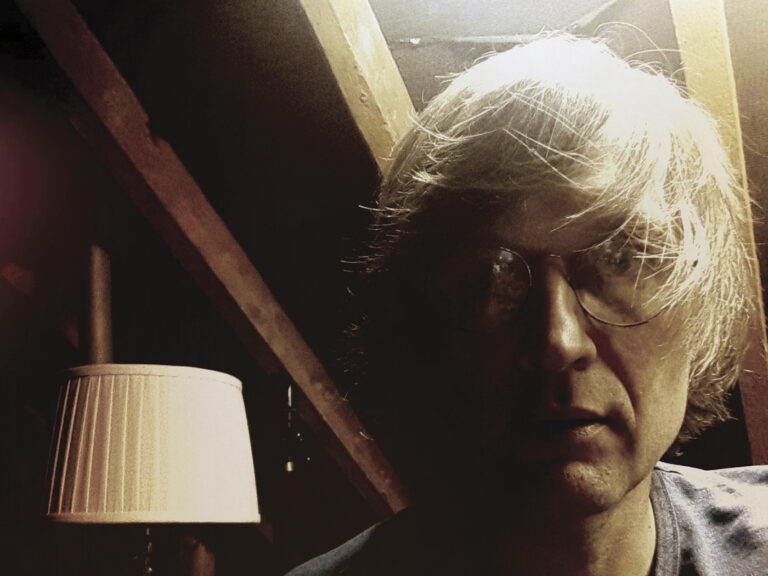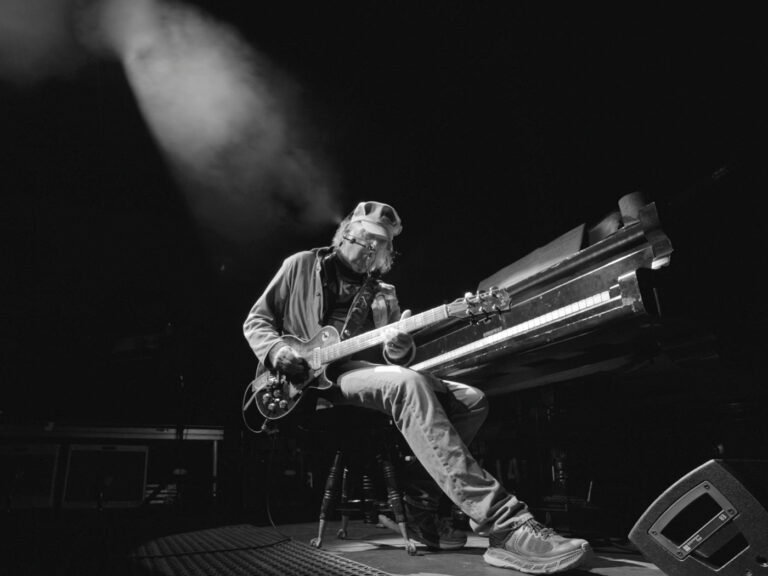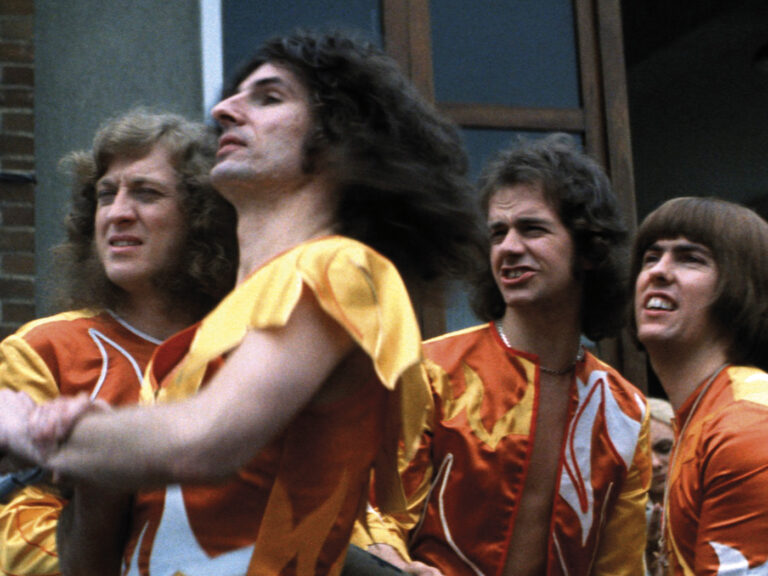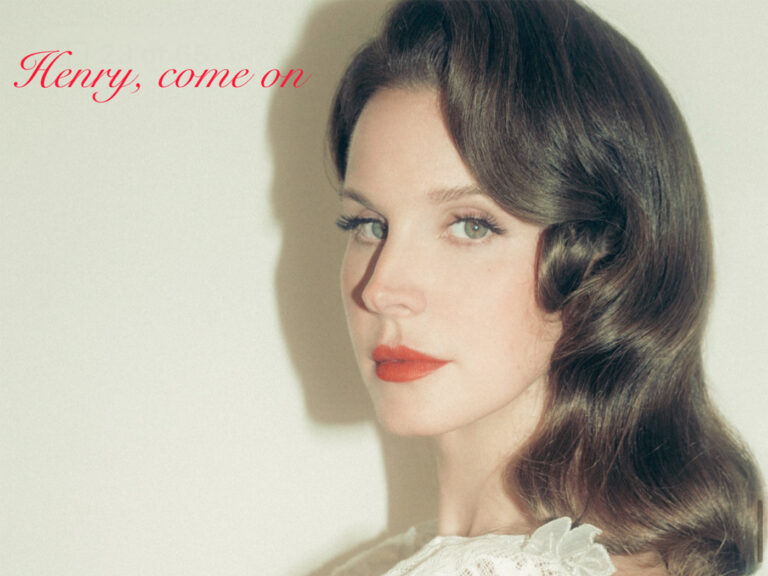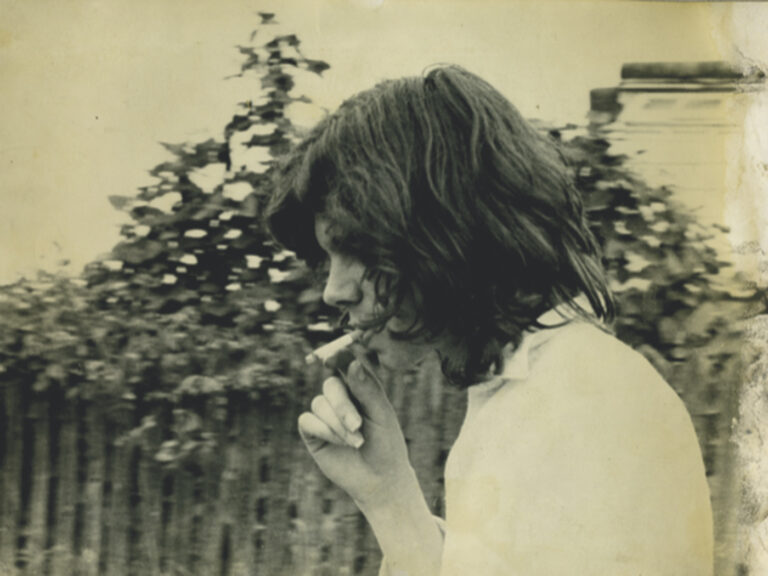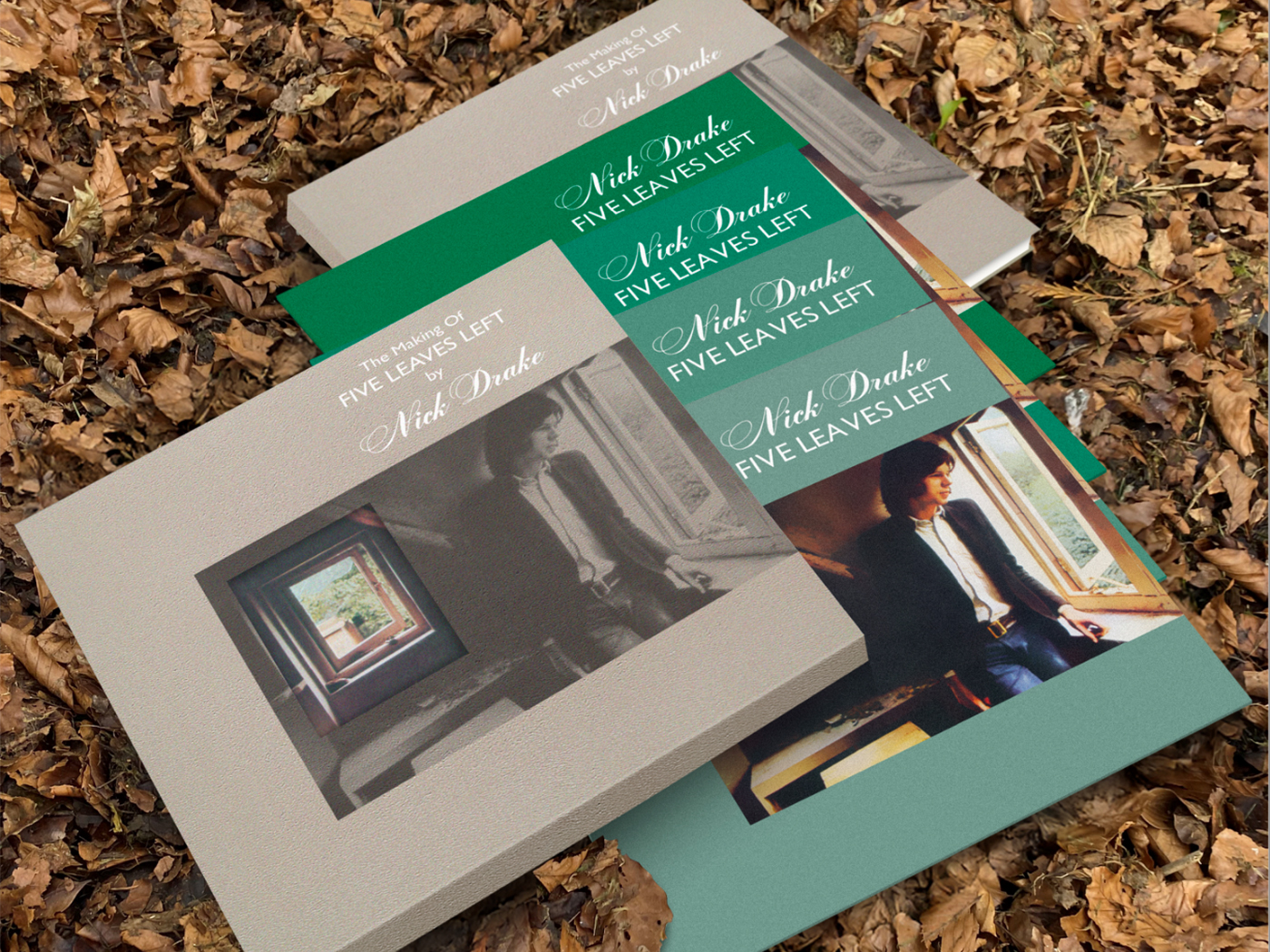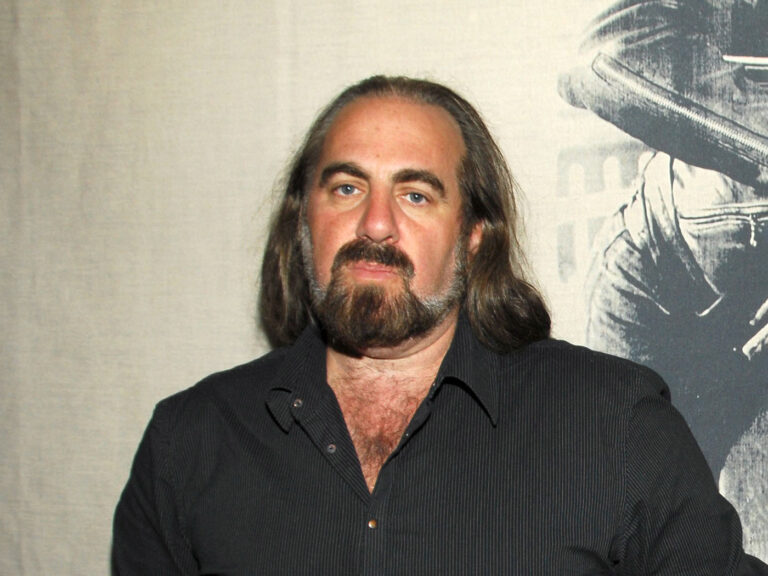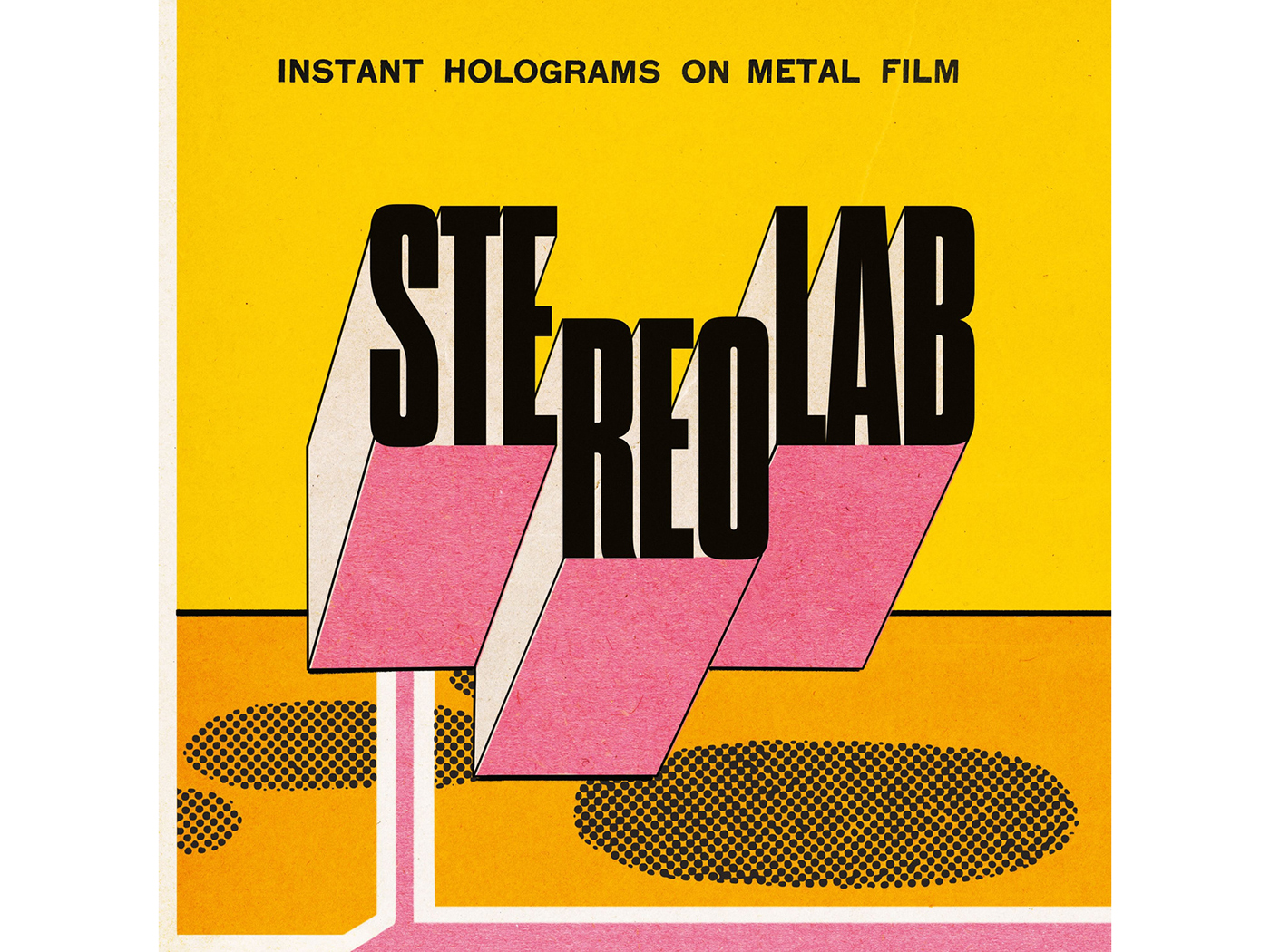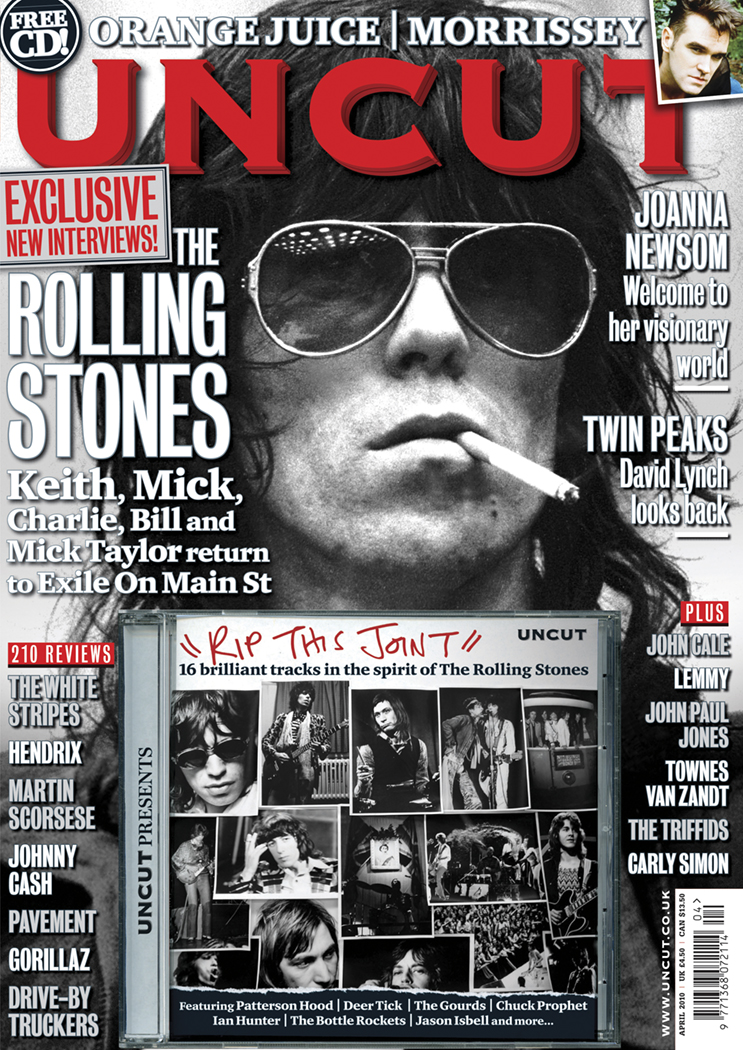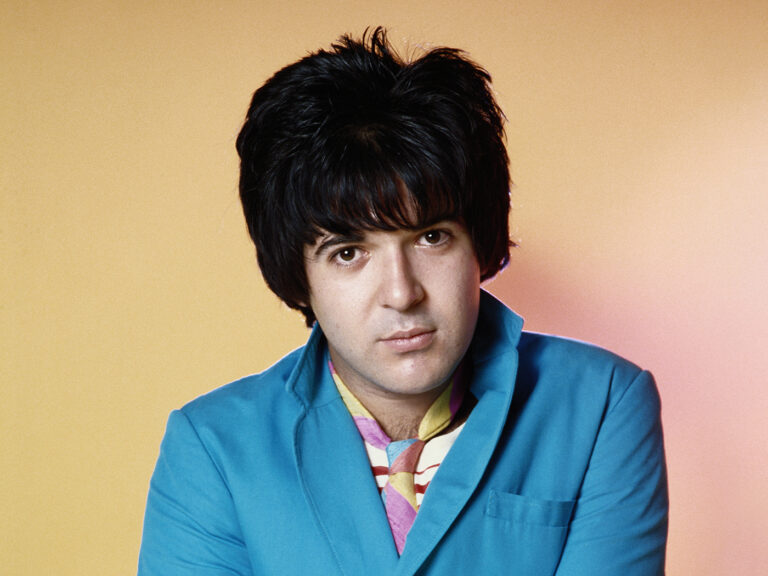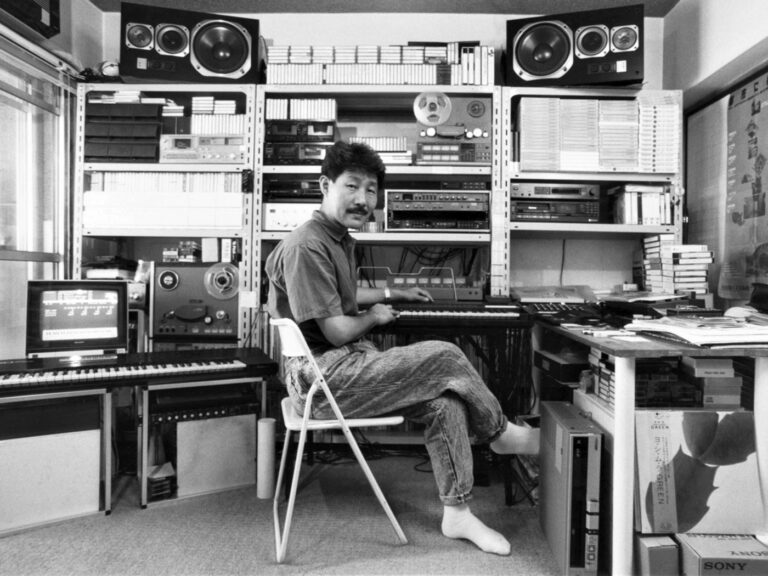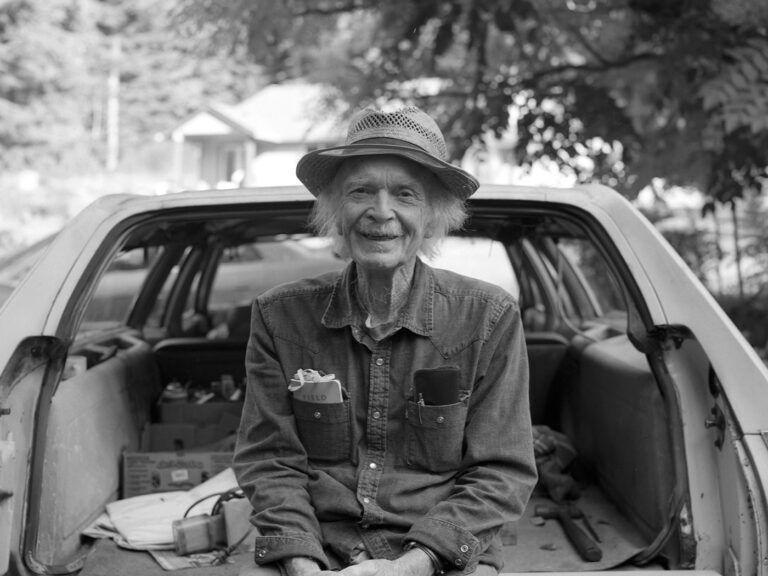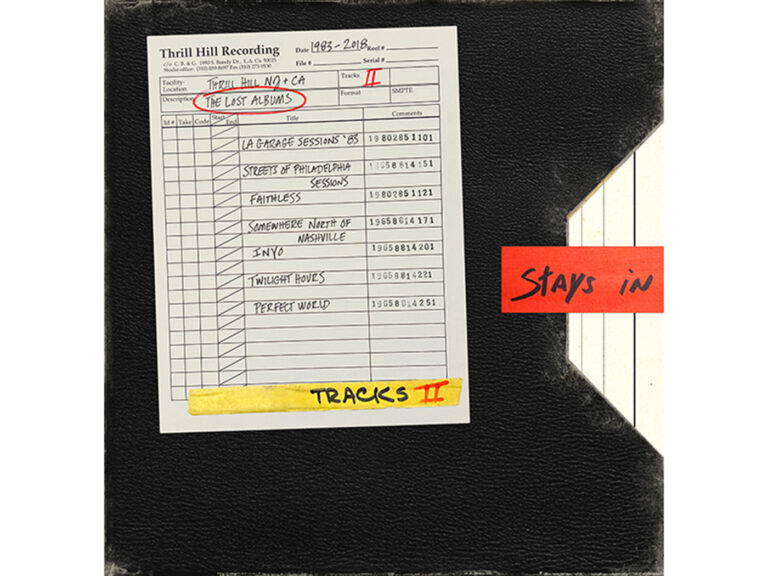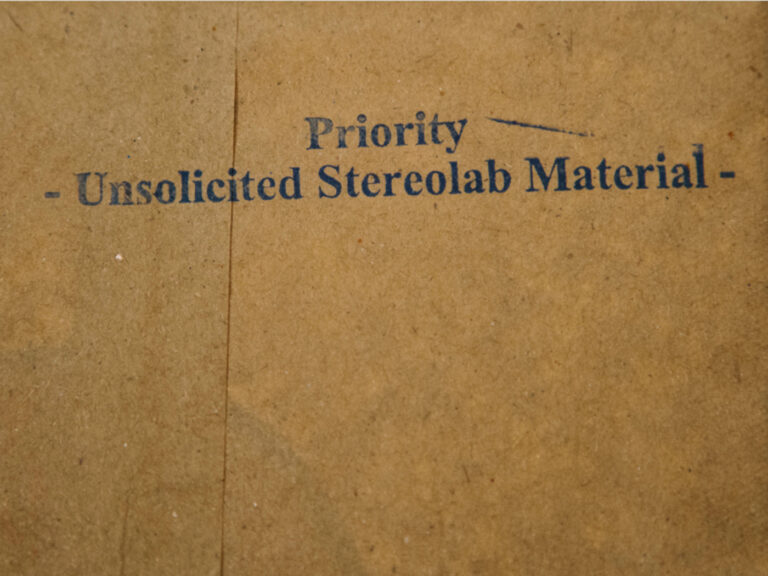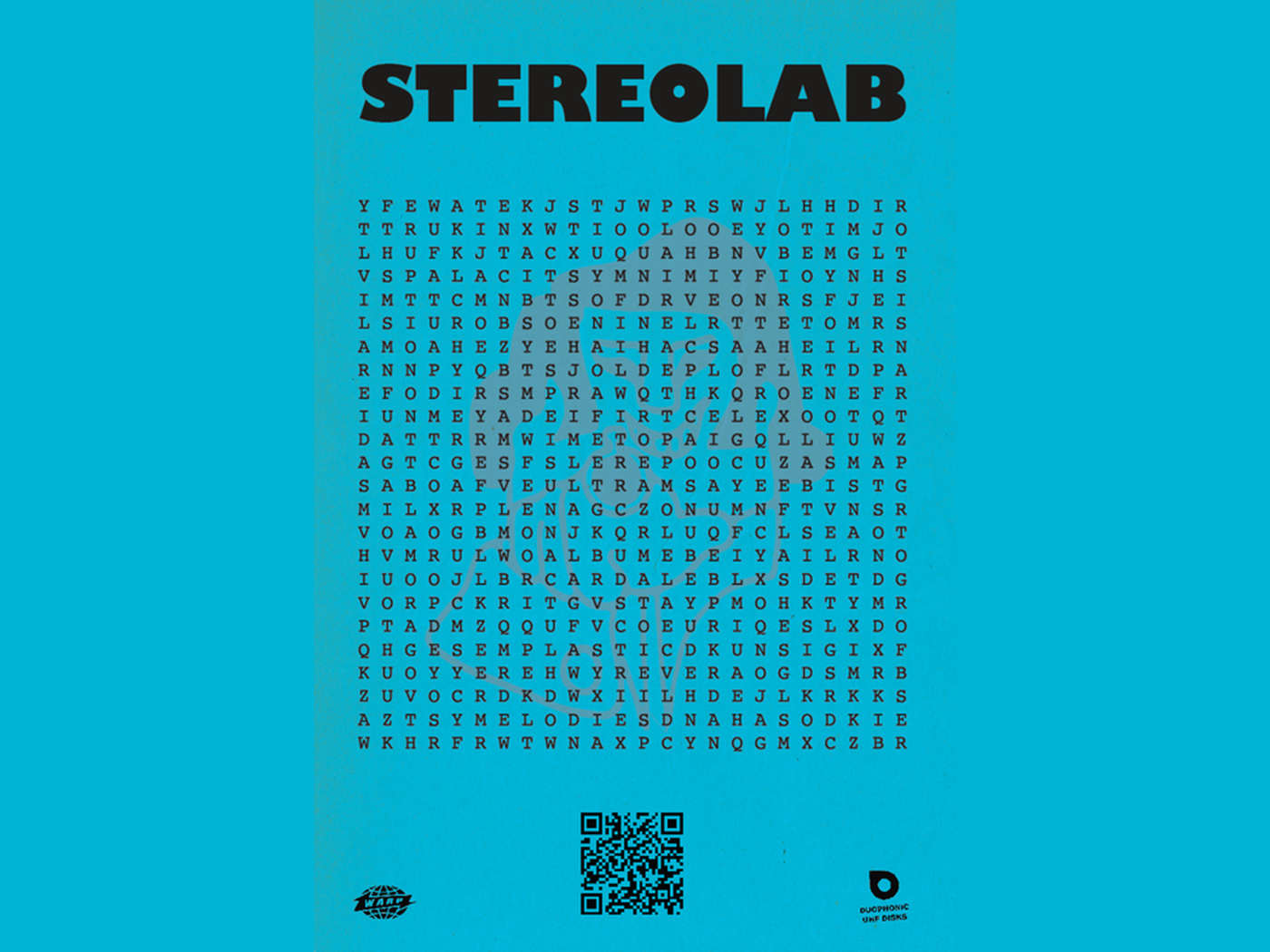This feature originally appeared in Uncut’s March 2022 [Take 298] issue
Join us at the blackberry bushes, where MICHAEL HURLEY can be found cutting back the foliage deep in the Oregon wilderness. As the veteran folk singer prepares to release a new album, The Time Of The Foxgloves, he leads Stephen Deusner through his wild and idiosyncratic career – from Greenwich Village in the ’60s onwards. Stand by for many marvellous digressions, sundry gardening tips and a glimpse into “Snocko Time”. Oh, and Bob Dylan? “That’s a bad question.”
Michael Hurley was cutting back blackberry bushes in his front yard when inspiration struck. It’s hard, back-breaking work even for a young man, but even more taxing for an 80-year-old. Still, it’s absolutely necessary when you live deep in the Oregon wilderness. “It’s not something you can do quickly because they’re very prickly and incredibly aggressive,” he explains. “Their defences are good. They can loop a vine over the top of a tree, come down the other side and replant another bunch of bushes. If you let them, they’ll take over your house. It’s like an alien invasion.” A tasty alien invasion? “If I find a really good bunch that are really ripe, I’ll get distracted and just eat them on the spot. Sometimes you can find hundreds of them that are pretty delicious.”
There’s very little that will take him away from this ongoing battle with the wild flora constantly threatening his domicile, but he’ll drop everything for a song. “One day a little something just floated into my head, a little music phrase connected to a few words. ‘Did you ever leave Nelsonville with a broken heart?’ I thought, ‘Well, if I don’t record it right now, I’ll forget it in an hour.’ I’ve got a little music room in my house, right off the kitchen. It’s got some microphones and a TEAC recorder from 1978. I use quarter-inch tape. It’ll take a 15-inch reel or a 7-inch reel. It’s got two speeds. I find it very satisfactory to my needs.”
So Hurley dropped his tools and ran into the house, where he spent the next few hours writing “Are You Here For The Festival?” which has become the opening track of his new album, The Time Of The Foxgloves. It’s an affectionate ode to the fun of live performances and all the shenanigans you can get up to when you put a lot of musicians together in the same place. Nelsonville, he explains, is not just a small town in eastern Ohio, but also one of his favourite music festivals. “I played there just about every year they had it. I was good friends with the promoter – I was the first person he ever arranged a gig for, back in ’98 or ’99 when I was living in Portsmouth. He’s very good at getting people to show up at things. He kept asking if I wanted to play the festival again and I always did. I don’t know if they’re going to have another one, but I’ll be there if they do, although I won’t be flying. I don’t fly on airplanes after the pandemonic. So I’ll have to drive that route, maybe set up some other shows around it so it’s not just 10 days on the road. I wrote the line about Woodstock so that people will get the idea, even if they don’t know anything about Nelsonville. Of course, I’ve never been to Woodstock. I wasn’t there for that particular festival…”
In conversation Hurley seems to rearrange time, contracting or distending moments based on whim or obsession, bouncing around from one subject to the next. He does something similar in his songs – rushing a phrase here, sustaining a yodel there, doing the Charleston around the metre of a melody. Some of his friends and fans refer to it as Snocko Time, after the cartoon alter ego he invented for himself decades ago. Rather than frustrating, it adds an air of mystery and mischief to an artist who is always attuned to the next song, the next burst of inspiration. When it hits, he’ll stop whatever he’s doing whenever an idea gets caught in the synapses of his brain and he’ll do take after take after take to get it just right. For nearly 60 years he’s been making music that is playful and impish, gleefully upending the pieties that often define folk music. His songs are strange, singular, sometimes inscrutable, but they always sound spontaneous, as though he just tossed it off. In fact, a lot of difficult labour goes into making music that creaks and shivers and whinnies and blows razzberries at the establishment.
“There’s a dreamy, mystical quality to Hurley’s music,” says Calexico’s Joey Burns, a friend and fan for 30 years. “There aren’t too many musicians who are as worldly as he is, but at the same time so introverted, who write so much about imaginative characters on the outside of everyday life. There’s a joy following him on his journey. Listening to his music, it’s like you’re in a canoe paddling at his speed, stopping wherever he wants to stop, taking notice of the waterdogs or whatever he wants to point out. You get into his groove, into the energy of his phrasing and the vibe of his playing.”
Michael Hurley lives just outside Astoria, Oregon – a small town situated right at the mouth of the Columbia River. “It’s the geography cradle,” he says. “It’s all beautiful – the ocean, the river delta, all those other descriptions for bodies of water… estuary, swamp, wetland.”
This place, about two hours northwest of Portland, exerts an incredible influence on The Time Of The Foxgloves, whose songs sound like they’re settled deep in the hollers and hills of the countryside. He moved here in 2002, after a lifetime of rambling from one place to another, never staying too long in New York City or Virginia or Ohio or Florida or locales in between.
“I used to pass through Astoria quite often back in the ’70s and ’80s, and I wanted to live here ever since my first visit. I just never pulled it off until after 9/11. I drove out here and just never left.” It was the beauty of the place that attracted him, the oddball vibe of the small town, an out-of-the-way paradise not too different from Woodstock or Laurel Canyon. “There were only one or two places to play back when I moved here. I remember one writer who said he’d never want to live in Astoria. Said it was a ‘raw bonefish town’ – which it was. But now it has some culture. Lots of music. Lots of art.” Hurley fits in well here; in addition to making music, he is also a renowned painter and illustrator, with a style that draws from old comic books of the ’50s and underground ’zines of the late ’60s and ’70s.
The town has exploded over the last 20 years, with a swell of tourists and an influx of new restaurants and bars, including the Fort George Brewery & Public House. “It’s the most successful business that’s hit Astoria since the beginning of the 21st century. If you want your business to succeed, make it a brewery! We’ve got five already, plus a winery and a distillery.” The Fort George in particular has become a hub for the town’s surprisingly lively music scene, full of artists who’ve fled Portland for cheaper rents and a less urban setting. Gradually, even as he moved farther from town, Hurley has found himself at the centre of that scene, sharing bills and stages with players young enough to be his grandchildren – like Kati Claborn and Luke Ydstie. After spending years playing in the roots-rock band Blind Pilot, they formed their own folk duo called The Hackles and kept bumping into Hurley at the Fort George.
Some of those younger musicians prodded Hurley to take some of his home recordings to a small local studio called the Rope Room. He finally agreed, corralling a small crew of local musicians to add woodwinds, bells, keys, fiddles and random sounds to the songs he had gathered for The Time Of The Foxgloves. “We’d just sit with Michael and try stuff out and he would lead,” says Claborn of this very Astoria album. “He was fairly hands-off with what other people were doing, but he had a lot of mood ideas and he was very active. He was very present, listening to every single take. He thinks very extensively about everything he does. It may not be the typical way of thinking about things, but he’s very intentional about every detail. You have to be a really good listener to play with him, because he’ll just take a huge right turn in the middle of a song. You really have to meet him where he’s at.”
Where he’s usually at is his two remote acres of land, about 20 miles outside of Astoria, where he fights off encroaching species of flora, records new songs, tinkers with all sorts of contraptions and spends long hours painting and drawing at his kitchen table. “Astoria is still my go-to town for groceries,” he says. “But sometimes I have to make that trip into Portland.” He’ll also wander into town for his frequent shows at the Fort George and several other venues that have popped up in recent years, or he’ll drive down to Scappoose for his monthly performance at the Rosebud Café. “My friends don’t take a rest, but me, I take a rest. I might average two or three gigs a month now. Except in winter. I’m not too mobile in the winter. I get more active in the spring and especially the summer.”
Hurley’s story begins on the other side of America – nearly 3,000 miles east of Astoria. Growing up in the ’40s and ’50s, he was the scourge of Bucks County, Pennsylvania, a troublemaker and rabble-rouser who pulled ingenious pranks all over town. He greased the railroad tracks near the train depot, causing the engines to slide a mile or so before stopping. One of his favourite games was filling a pop bottle with water and pretending it’s wine, then find a tree he could pretend was a lamppost on the Bowery; he’d spend an afternoon pretending to get drunker and drunker, then pass out in the dirt for hours. He started his own ’zine in high school called Outcry, featuring his own rambling writing and bizarre illustrations – a very early version of an underground comic.
But most of all he loved music. All kinds, too: blues and folk and jazz, but also the little pop and country ditties on the radio, with Jim Reeves’ 1959 confection “Put Your Sweet Lips A Little Closer To The Phone” among his favourites. Even as a teenager he understood that rural Bucks County wasn’t going to foster his talents. “I was a blues fan and there were only five blues artists I could buy. I knew there was more than that out there! I still like to buy the LP, even though everything’s online. I’m not alone. The jacket can have a lot of information and pictures. When you get a nice insert, a big 12 x 12 folding piece of paper, you can practically write a book.”
As a teenager, he pulled up stakes for New York City in the late 1950s, where he recorded his debut album, First Songs, on some of the same portable machines that had been recently used for Lead Belly’s final sessions. He also played at some of the same coffeehouses and venues as Bob Dylan, Dave Van Ronk and Karen Dalton. When asked about that scene and some of its personalities, however, he responds cryptically: “That’s a bad question.”
Hurley can come across as evasive, giving short answers about the past but rambling on about minor matters. He’ll hold forth on his obsession with eight-tracks but will nimbly sidestep inquiries into his run-ins with famous contemporaries. Fortunately, his contemporaries are much more forthcoming about Hurley. “When I met him in ’63, he looked like a leprechaun,” says Peter Stampfel, Hurley’s friend and founder of the like-minded Holy Modal Rounders. “He had an angular face. He was a nice, soft-spoken guy. He had written some really cool songs. He actually lived with me for a while on the Lower East Side, in this real slum of a building. But rents were cheap and the neighbourhood was relatively safe. We all thought that drugs and music were going to save the world. It all started to go downhill in 1967, but at the time we thought what was going on was miraculous. We thought we were hurtling toward an unimaginably bright future. Ha!”
Hurley watched the counterculture curdle, but he and a small group of friends and collaborators stuck to their outsider principles, with groups like the Holy Modal Rounders and Jeffrey Schneider & The Clamtones making music that was wild and subversive, often hilarious. The scene, such as it was, coalesced briefly in the mid-1970s with an LP called Have Moicy!, a singular record that gleefully pulling the rug out from under the serious folk-rock and singer-songwriter trends of that decade. It sounds like a comic strip come to life, full of surreal images, stoned wordplay, deep meditations on death, heartbreak and sex – and one vulgar singalong about the digestive process, courtesy of Hurley himself. “We fill up our guts”, he sings on “Slurf Song”, leading the crew in a scatological chorus. “We turn it into shit, then we get rid of it!”
As he continued recording and releasing whenever the mood struck him, Michael Hurley’s music grew more rustic and more idiosyncratic, marked by his strange timing and phrasing. His guitar playing dances around the metre, not unlike Willie Nelson while his voice somehow sounded younger and spryer as the years added more grain. His songs had a lo-fi quality, like tubers pulled up from the garden still crusted with dirt. That strangeness and apparent spontaneity attracted new generations of fans who made Have Moicy! and 1977’s Long Journey and 1980’s Snockgrass into cult totems.
Behind the grandfatherly eccentric was a dogged perfectionist who worked determinedly to get the ideal take on every song and who held back all but the most mesmerising performances. “I do most of my recording at home. I can be a lot more selective about tech and I won’t be putting anybody out. If I go into the studio to do a vocal take, there’s an engineer there and there are people there just wanting to get the job done. So I feel rushed. But at home, my time is unlimited. I can go for hours until I get it just right. But my sound quality is not up today’s standards. I noticed that the average DJ won’t play anything that didn’t probably cost $20,000 to make. They don’t want to mess with the homemade stuff. But it gets too perfect, you know. I say ‘perfect’ is boring. The tendency these days is to make music that is too pristine. You don’t hear any humanity in it.”
The 1990s saw renewed interest in Hurley, with Calexico, Cat Power, Victoria Williams and others singing his praises, sharing his stages and covering his songs. Son Volt even took him out on the road, an unusual pairing that frontman Jay Farrar credits to the band’s love of Hurley’s 1994 album Wolfways. It was, he says, “a mainstay while touring in the mid-’90s. We eventually did a handful of shows with Michael. There was always an air of mystery about him, as his recordings were difficult to find. He was obviously a master of his craft, but there was always a sense that he was giving us an edited version of what he was capable of.” Still, he made for good company during long drives between gigs. “He was easygoing but was adamant that we stop for some roadside dinosaurs in Wisconsin.”
His popularity hit a new peak during the 2000s, when he was touted as the forefather of the freak folk movement. It was during this time that Josephine Foster crossed paths with him and struck up a long friendship. “I’d just show up at his place in Astoria over the years,” she says. “We’d be telling stories or I’d sit and watch him draw at his kitchen table. Sometimes we’d do a little recording together.” During one of her visits in 2018, Hurley was deep into an obsession with old gospel tunes, in particular the old hymn “Jacob’s Ladder”. “I don’t know when or where I first heard it,” he says. “It’s just something I’ve been hearing all my life and I got into singing it for a while.” They decided to record it together, with him playing guitar and her on his “out-of-whack” pump organ. Despite the lack of rehearsals and a few missed notes, they thought the take turned out beautifully. Their excitement was short-lived, as they soon discovered that Hurley’s trusty TEAC had malfunctioned. They’d lost that incredible performance, which hit him particularly hard. “We did a few more takes, but it was clear he was pretty frustrated. We couldn’t get it again. It took him several years to get over it, but I guess at some point he got used to that other take and he started liking it.” After taking their duet to the Rope Room, where a local musician named Nate Lumbard added bass clarinet and xylophone, the song became a standout on …Foxgloves – a spiritual contrast to Hurley’s earthier songs.
Foxgloves ends with a plaintive country reverie called “Lush Green Trees”, which features Hurley yodelling and duetting with a reedy saxophone.
It’s one of two older songs that he reassessed, rearranged and rerecorded for this new album. It’s something he’s been doing for decades now, operating as though a song isn’t finished once it’s been recorded and released into the world. In fact, some songs are never done, at least not to his satisfaction. “I’m still trying to get them right!” he declares. “I’m still trying to get them as good as I think they should be. And I think this version of ‘Lush Green Trees’ is better here than it was on Watertower or Wolfways.”
It might be tempting to read a lot into these particular do-overs, to interpret “Lush Green Trees” and the new version of “Love Is The Closest Thing” as commentaries on growing older. And certainly, the songs seem to mean something very different now than they did when he was younger. “Sorrow, sorrow, cold sorrow”, he sings, with no fear or trembling in his voice. “Can’t you ignore me please, and leave me on days like these?” He’s living on Snocko Time, drawing out pleasant moments and savouring sunny summer days.
But in many ways Hurley still comes across as the same kid who terrorised Bucks County. His drawings are still grounded in the artwork he did for Outcry, and his new music isn’t too different from the music he’s made at other points in his career, which is a testament to the sturdiness of his craft and the consistency of his vast catalogue. …Foxgloves doesn’t depict an 80-year-old artist slowing down. In fact, he brought so many good takes into the studio that he has enough material for a second volume, which he hopes to release soon. In other words, he’s not letting the blackberries overtake his home any time soon.
Hence the title, which refers to a very different plant, one much less invasive and much less aggressive. “The foxglove,” says Hurley, “sticks up about three feet from the ground and has all these little bell-shaped flowers on it – maybe 20 or so. It’s a very beautiful plant and I just started noticing them when I moved out here to my house. They’re a really wild flower. I became a fan. They can exist as early as June and as late as August, but they’re really at their peak in July. July is my favourite month, the best days of the year. It’s such a beautiful time.”


